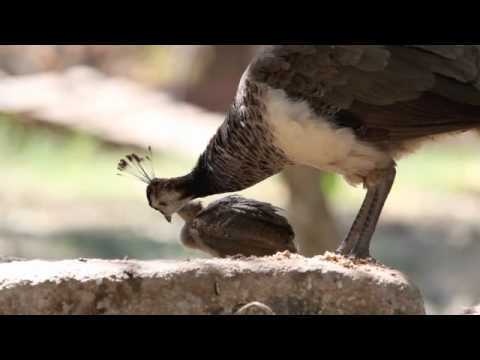I have a question: Do congo peafowl display in any way?
Congo Peafowl perform elaborate flight displays. Both sexes engage in pair bonding rituals year round. They are strongly monogamous.
When the male
radiates with its tale spread, the brilliant blue violet velvet fringe at the tips of the retrices form a semi circle with the secondary wing covert speculum. The breast feathers are highly specialised -especially the flank plumes which are elongated and similar in structure to the crest of a goura pigeon's crest. These plumes are highly iridescent and are held out in a manner not unlike those of a turkey. These plumes match the secondary speculums on the wings and tail tips in hue and vibrance. The area immediately behind the lower neck where the upper back meets the neck is the most vividly coloured area on the body. When the male is radiating this patch is extended and becomes very visible. Indeed- the whole neck is transformed during this display behavior. The head is held at an odd angle- we would fire a taxidermist that stretched the bird into such a strange shape. The bill is held against the throat - the entire gular region is inflated. It's bare skin glows a different hue- it becomes much more intense. A brilliant circular spot appears behind the eye of the male -the forecrest is expanded into a vibrating pin cushion-
The fascinating thing about
Afropavo while in radiating posture- and this is difficult to articulate- the entire bird- the male Congo Peafowl- while standing in its radiation posture "fanning" as it's sometimes described- the bird resembles an enormous eye spot- a single ocelli as we observe in the
Pavo males' train.
The breast is black surrounded by vivid iridescence -the upper tail coverts and shoulder scapulars are neutral bronze - they frame the brilliant iridescent ring surrounding the colourless black, light absorbing centre. I can't really articulate what I'm talking about- but will post a photo of it or an illustration one of these days.
Aren't they really pheasants ?
No. Congo Peafowl are the closest living relatives of the typical
Pavo peafowls. They are also related to Crested and Great Argus. These four genera constitute a single ancient and highly isolated lineage- the peafowl family.
The closest relative of that lineage is actually the Chukar and it's relatives, which are in turn allied with Coturnix.
The relationship between the Chukar/Coturnix lineage and the Peafowl lineage is ~ analogous with how closely related Rhinoceros/Tapir are related to Horses. The three mammals aforementioned are all descended of a common ancestor and directly related but derived very early on in their development- with the respective evolutionary history of each of the three members of the
Perissodactyla having highly diversified over these many millions of years.
On that thought- the Hippo -which superficially might resemble a Rhino in some way -is actually a member of its own ancient lineage- with its own unique evolutionary history. The Pheasants are ~ analogous with the Hippo in this instance- they superficially resemble peafowl but are members or respective lineages. The Peafowl are literally millions of years older than the pheasant/grouse/turkey lineage. Ironically, the Hungarian Grey Partridge
Perdix is a pheasant. It is called a partridge and this name is now used to describe the Chukar and its relatives. But the Chukar is essentially unrelated to the Grey Partridge. They resemble one another only superficially.
Quote:
Kermit, You are the man when it comes to incredible photos. Thanks once again for always sharing these. Shawn
Thanks Shawn- I'll try and post some more photos in the near future- very busy this time of year.
I agree with Shawn. Kermit, you're the best!!
Actually bdfive- you are one of the reasons I take the time to write here. Someone needs to educate the next generation of pavonine aviculturists.



